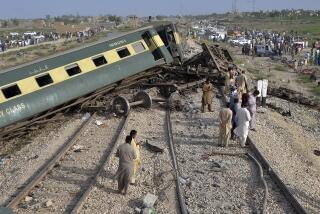India train crash leaves 65 dead in West Bengal state
- Share via
Reporting from New Delhi — — Sabotage by Maoist rebels was suspected after an Indian passenger train derailed early Friday, sending railroad cars crashing onto an adjoining track. An oncoming freight train slammed into many of those cars, killing at least 65 people and injuring 200.
The area of West Bengal state where the disaster occurred, near the city of Sardiha and about 90 miles southwest of Kolkata, formerly Calcutta, is a known Maoist stronghold that has seen several recent attacks.
There was initial confusion on the exact cause of the disaster, with some officials and the engineer on the passenger train blaming an explosion, some uninjured passengers saying they heard no blast, and police saying metal parts used to hold sections of track together were missing and apparently removed in an act of sabotage.
India’s aging railroads experience their highest volume of travelers in May, with more than 20 million passengers each day on the 69,300-mile system.
The disaster occurred about 1:30 a.m., when most passengers were sleeping, and it took more than an hour for police and medical crews to reach the site.
Even then, rescue operations were hampered by the lack of roads, the blocked tracks and concern that the Maoists might have set an ambush or booby trap to kill rescue crews rushing to the scene.
Angry passengers complained of the slow response, with some claiming that luggage and valuables were stolen by onlookers in the confusion.
E. Mitra, a doctor at nearby Kharagpur Railway Hospital, said 30 bodies had been taken there, but “a lot of dead bodies are strewn under the derailed carriages.”
Samar Ghosh, home secretary of West Bengal state, said that 65 bodies had been found.
As dawn broke, air force helicopters scrambled to assist as video footage showed crowds of onlookers standing on the roof of derailed carriages, watching soldiers cutting holes in a rail car roof with a gas-powered circular saw.
Authorities said 13 cars of the Gyaneshwari Express traveling to Mumbai from Howrah derailed. Three were mangled. Many of the casualties were reportedly caused by the collision with the freight train. Video showed the freight train engine fused at a right angle to one of the rear passenger cars.
Vivek Sahai, a Railways Ministry official, said Maoists had declared a “black week” starting midnight Thursday, a period of strikes and stepped-up activities against the government, so transportation workers were on alert.
“There was a massive jerk, and we thought the Maoists had stopped the train to hijack it,” an unidentified witness told a local TV station. “But thank God it was an accident … at least many people are saved. This area is very dangerous, very dangerous.”
A railway worker reportedly examined the section of track at 11 p.m., a little more than two hours earlier, and reported no problem. Four trains had reportedly passed over the line in the previous 90 minutes.
Mamata Banerjee, India’s railways minister and a politician from West Bengal, rushed to the scene to announce compensation of $11,000 and a job in her ministry for the families of those killed and $2,200 for anyone injured.
In October, a train in the area was seized for several hours by Maoists before being released. In March and earlier this month, Maoists blew up railroad tracks nearby.
“Police in the area now have raised quite a good force and have been carrying out operations, so they are targeting weak spots,” said B.K. Ponwar, head of the Counter-Terrorism and Jungle Warfare College based in Jharkhand state, also a Maoist stronghold. “It’s easy to make [an explosive] contraption; only one person can set it.
“The easiest is railway tracks,” Ponwar added. “They can’t be guarded everywhere.”
Maoists, who have been battling the government for decades, operate in 20 of India’s 28 states and have 10,000 to 20,000 fighters, according to the Home Ministry.
Concentrated in some of India’s most impoverished states, the Maoists have won support from the poor, especially landless peasants angry over local corruption, weak governance and the growing wealth gap. Despite India’s high economic growth rates, vast numbers of people have not seen much improvement in their lives.
In many places, the government controls the roads, but the Maoists control the jungle and villages. Aware that their strength depends on the state’s continued ineffectiveness, militants often attack infrastructure as well as police and army patrols.
In recent months, the militants have increased attacks in response to a police and army offensive initiated late last year across several “red corridor” states.
The rebels are funded in part by hundreds of millions of dollars that they extort each year by threatening companies. Their arsenal includes automatic rifles, shoulder-fired rocket launchers, mines and related explosives, some of which have been stolen from Indian authorities and some purchased from Chinese smugglers.
Anshul Rana in The Times’ New Delhi Bureau contributed to this report.
More to Read
Sign up for Essential California
The most important California stories and recommendations in your inbox every morning.
You may occasionally receive promotional content from the Los Angeles Times.













